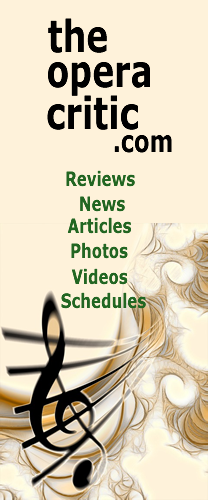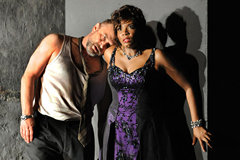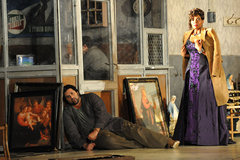| Opera Reviews | 27 April 2024 |
| Not
for all tastes by Sarah Noble |
|
| Puccini: Tosca Opera Australia Sydney Opera House 8 January 2010 |
|
|
For director Christopher Alden, it seems the answer is nothing short of a radical update. His controversial staging (imported from Opera North) discards tradition and thrusts the opera under the harsh light of Berlusconi's Rome. This Tosca takes place within a disused church vestry, in which the frescos which Cavaradossi restores have been torn down in favour of political posters. Tosca herself is a brittle romanticist, whose dreams and delusion are her only escape from an unglamorous life; the police chief who destroys her is no tyrannical baron; just a sweaty sadist. Alden's update has its share of infelicities. While many of his risks pay off, some are less successful: Angelotti's disguise, for instance, is laughable, and the very unconventional death of Cavaradossi needs stronger staging. But the intensity and truthfulness of Alden's Tosca vindicate its liberties and its inconsistencies; its uncomfortable elements are tellingly reflected in the score, even as they openly contradict the libretto. Key to the show's success is the confident performance of its Tosca, American soprano Takesha Meshé Kizart. Kizart, who has sung in Alden's staging before, meets its unconventional challenges with gutsy self-possession, persuasively charting Tosca's slide into total nervous breakdown. Her fiery, fearless singing explodes with passion; while a touch more refinement might be welcome at times, particularly in the middle register, at the role's dynamic extremes - the exquisite pianissimi of her "Vissi d'arte", her vicious confrontation with Scarpia - she is simply thrilling. As Cavaradossi, Rosario La Spina gives a respectable, if not superlative
vocal performance, displaying increased security in his lower register
and better regulated legato; his top notes, however, show an unfortunate
tendency to falter under pressure. More problematic is his placid, anachronistic
stage presence. While appealing in early scenes, he seems unable to engage
with the darker psychology of the ensuing horror, and neither his own
suffering, nor that of others, elicits much response. This may be intentional
- Alden seems keen to create an all-pervading air of alienation - but
La Spina's blank delivery makes it difficult to tell. |
|
|
Among the supporting cast, Warwick Fyfe is a particular standout as a greasy and godless Sacristan. His deep-set baritone has rarely sounded better, and he strikes a convincing balance between comic bumbling and reprehensible apathy. Graeme Macfarlane and Luke Gabbedy are a cruel pair as Spoletta and Sciarrone, making a strong case for Alden's enlargement of both their roles. They're present throughout the opera; even when silent, the blind eye they wilfully turn to Scarpia's rape of Tosca speaks volumes. Jud Arthur is impressive as the escaped prisoner Angelotti; more striking still is Sian Pendry, as his usually unseen sister. Trapped in the room, she watches the evening's proceedings with growing horror, eventually singing the shepherd boy's song when her brother's body is dragged inside. Maestro Andrea Licata leads the AOBO through a cohesive reading of Puccini's score; some untidy ensemble playing early on opening night was soon smoothed out. His tempi are a little slow - Cavaradossi's "Recondita armonia" is perhaps needlessly drawn out - but this deliberate approach eventually draws out the tension of the score, with the pulsating Act Two confrontation between Tosca and Scarpia especially well executed. The chorus makes much of its brief star turn, throwing itself forcefully into the climax of the Te Deum. This is hardly a Tosca for all tastes. What some will deem thought-provoking, others will no doubt dismiss as tasteless. Opera Australia has taken a risk in producing it - and so they should. Like the combination of wild applause and vociferous booing which met the cast and director on opening night, an energetically mixed reaction is irrefutable proof of life: a fitting, if less than traditional way to kick off a brand new season. |
|
| Text ©
Sarah Noble Photos © Branco Gaica |

 The
libretto of Puccini's Tosca is more precise than most about the
exact time and place of its setting. Yet that very specificity can be
the downfall of its drama: the trappings of literalism are liable to distance
us from the darker forces at play in an opera which, for all the beauty
it possesses, ultimately tells a nihilistic tale. How, then, to bring
the ugliness of Tosca level with its loveliness?
The
libretto of Puccini's Tosca is more precise than most about the
exact time and place of its setting. Yet that very specificity can be
the downfall of its drama: the trappings of literalism are liable to distance
us from the darker forces at play in an opera which, for all the beauty
it possesses, ultimately tells a nihilistic tale. How, then, to bring
the ugliness of Tosca level with its loveliness?  Completing
the tortured trio is the deeply creepy Scarpia of John Wegner. Alden's
staging removes most of the character's usual dignity, leaving instead
a perverted individual, whose sick fascination with Tosca and obsession
with power have twisted together into single-minded, sleazy brutality.
Even his own henchmen despise him, something made abundantly clear by
Alden's surprise ending. He's dignified only by Wegner's Stygian baritone,
whose careful phrasing and exemplary dynamic control make this performance
the best kind of hideous; anorak or not, he dominates the Te Deum in Act
One with terrible majesty.
Completing
the tortured trio is the deeply creepy Scarpia of John Wegner. Alden's
staging removes most of the character's usual dignity, leaving instead
a perverted individual, whose sick fascination with Tosca and obsession
with power have twisted together into single-minded, sleazy brutality.
Even his own henchmen despise him, something made abundantly clear by
Alden's surprise ending. He's dignified only by Wegner's Stygian baritone,
whose careful phrasing and exemplary dynamic control make this performance
the best kind of hideous; anorak or not, he dominates the Te Deum in Act
One with terrible majesty. 





